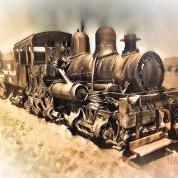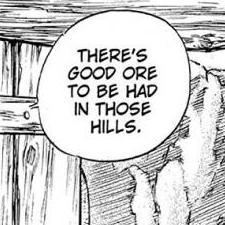
arftist
Members-
Posts
2,699 -
Joined
-
Last visited
Profile Information
-
Gender
Not Telling
-
Location
New England
Converted
-
Location
New England
Recent Profile Visitors
17,544 profile views
-
Amit kumar Bhakta started following arftist
-
If you have 20 of them all the same brand, it is worth doing some testing to find out. Professional knife makers use known steels for the convivence and ease, however for practice you can certainly reuse used tool steel if they meet enough criteria. I don't have all night to explain it to you but if you search this site you should be able to find guidelines to use junk yard steels. Rasps can make good knives but certainly grind off all the teeth before you start. Old circular saws are usually a very good alloy for practice knife making as well. McRaven does a pretty good job of explaining junk yard steel knife making as well as Weygers.
-
You most certainly can cut and weld the cable with a torch. Buy an acetylene tank, a plumber's B tank will work and should be very cheap if bought used. Buy an "owner size" oxygen tank. Buy a torch set. Learn how to gas weld. Cut the wire with the cutting tip, then switch to a welding tip, adjust the pressures of the gases to neutral, equal low pressures and weld away, Rene. Others are correct though, that smaller diameter wire would be much less work overall. If you do this you will greatly expand your metal working capability for the least cost possible in terms of equipment outlay. When I was a student gas welding was still taught in the trade schools. It is a shame that it almost a forgotten art now, especially since it is so easy to do. Furthermore if you are a good gas welder, TIG welding is very easy to learn.
-
My main business is polished bronze pipe. I have a monster bench vise, a Charles Parker Trogan 727. I polished the jaws because I use it for the same thing all the time. For other vises I have made jaws from aluminum angle, plate and copper flashing.
-
Any good hand creams to reccomend?
arftist replied to Mr. Freshman's topic in Blacksmithing, General Discussion
What Frosty said, something with lanolin in it. Also Bag Balm and Norwegian Formula Hand Creme. -
Does my old Fisher have significant sale value?
arftist replied to Gravydavy's topic in Repairing and Modification to Anvils
I will say this. It is a Fisher in fair shape. It is an ideal size for most people. The 10 is the weight in tens. Made in America, it is marked in pounds, 10 at a time. My best by far Anvil is my Fisher. Among the other reasons mentioned the Fisher body is cast iron as opposed to wrought iron which is softer by far than cast iron. The Fisher anvil also had a much thicker top plate. As you can see it is a superior anvil. Though much harder to repair than other anvils it is less likely to need repair. That is likely why the US Navy chose them, and there is an English powerhammer built just for them. T We like them so much that there is a Fisher museum on the East Coast with a giant collection of Fisher so yes it is special and precious. Finally, it could ultimately (eventually)be "restored". It has a workable face now. Use it for a while before you make any changes and you will know what to do. -
How to minimise railing movement / optimise shock absorption?
arftist replied to castirongater's topic in Problem Solving
Fill the holes all the way to the top with lead. Expect the spindles to be able to bend a little. I have done a ton of these. -
It is a post vice made for blacksmithing by Fisher. Although the body is cast iron these vises, like Fisher anvils which are also cast iron are certainly made to have hot iron beaten in them. I did journeyman year in a shop with an 8 inch Fisher I good working order. I was worried about breaking it but was instructed by the owner that I couldn't hurt it. Of course I thought to myself "Oh Yeah?" If you are a collector don't use the shiny things. If you are a blacksmith hammer away Rene. It is a fantastic post vise.
-
Anvil on oak block- end grain vs side grain
arftist replied to Machine shop's topic in Stands for Anvils, Swage Blocks, etc
Slice 3" off the side of the Block and screw/ glue it to the bottom. The block is a little too big anyway IMHO. FYI Elm is The preferable wood for an anvil stump. -
For stick welding use 8018
-
Air Compressor Compression Fitting Breaking
arftist replied to Steven Bronstein's topic in Problem Solving
Coiled copper tubing should always be soft at least when new. Copper does "age" harden though so a quick anneal will ensure softness. To anneal copper heat pretty dang hot and quench in water. -
Wrong, not all log splitters use two stage pumps. I still believe you have other problems as well but you only answer selected questions and will not print a photo.
-
Too bad you didn't say it was a 2 stage pump in the OP. Thanks for wasting my time, glad you think it is funny. Your pump isn't switching into low gallon hy-press, correctly. I would still like to see a picture. Also what is your source for 3 phase?
-
Read your post again. Your math says it all. General rule of thumb for hydraulic engineering: 1 hp per gallon @ 1500 psi. Your pump is way too big for your motor. At 1500 your pump would require 16 hp to not stall. At 2500 it would require over 25hp.
-
With 1/2" work lines your pump pressure line should be 3/4 and pump supply should be 1". Picture and schematic should help a lot.
-
If you think it was fitted hot, it may have clenched tight to the wood yet still developed enough spring back that when the fasteners were released there was considerable gap. Now you are trying to fit it cold to a standard that only exists to you. You said you were heating where you are bending. How are you heating? I suggest cutting perhaps into two halfs. I also suggest buying an oxy-fuel torch. By allowing freedom of movement and using precise heating you should be able to push pull or hit the steel to exactly where you want it to go. I sincerely doubt it was made any other way.




